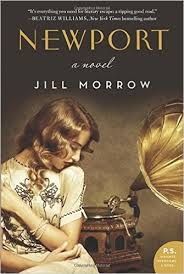Newport: A Novel
- By Jill Morrow
- William Morrow
- 356 pp.
- Reviewed by Jeanne Mackin
- August 13, 2015
A lack of mystery largely derails this otherwise promising ghost story.

Jill Morrow’s latest novel, Newport, has all the makings of a great ghost story: an eerie mansion, visitations from the unquiet dead, dastardly deeds, and a culture still reeling from events that have recently torn it apart (in this case, the Great War).
Ghosts are often metaphors for our own worst fears come back to haunt us, and that’s certainly the case in this entertaining novel. But what it lacks is a necessary ambiguity: In a great ghost story, the reader never knows with absolute certainty if the ghosts are real or not. The mystery should stay intact, even on the last page.
This is why Henry James’ The Turn of the Screw remains the ghost story against which all others are measured. Critics, 100 years later, still argue over whether or not the ghosts exist or are the gauzier result of the governess’ fevered imagination.
Whether or not the hauntings are real is answered by the culture reading the book: The Victorians believed in them wholeheartedly; post-Freudian readers often prefer treating ghosts as a case of sexual repression rather than an actual haunting. The fact is, though, both cases can be — and have been — argued effectively. Ultimately, our reading of a novel tells us as much about our own psychology and beliefs as the author’s.
As in James’ novel, Newport begins with a voyage so that the protagonist can fulfill a specific task. In 1921, attorney Adrian de la Noye travels to Rhode Island at the request of a client who wants to redo his will. Add in Adrian’s own secret past; the greedy and dissipated children of the wealthy, widowed client; a young woman who very much wants to wed this client; and the final element of a young spiritualist; and we have all the elements of a strong storyline.
Morrow weaves a complicated and well-constructed plot that kept me turning the pages at a good clip. It’s a pleasant read, and I enjoyed the author’s competent handling of the spiritualist aspect of the material. In Newport, however, the reader isn’t allowed the thrill of ambiguity. By the end of the book, we’re told that this haunting is real and are left with a campfire sense of the story finishing with no more questions to be asked.
In The Turn of the Screw, the reader becomes a juror, deciding the guilt or innocence of the governess; to paraphrase Henry James, if the reader sees evil, it comes from the reader’s own mind. In Newport, the reader is required to accept someone else’s decision about (and limits to) what is real and what is not. Nor has the jazz-age setting been used to its best advantage to add to the mood and atmosphere of the story. Instead, it feels tacked on.
In fact, the most mysterious relationship in this novel is not the one between wealthy widower and young fiancée, or unloving parent with even-less-loving children, but the one between Adrian and his young assistant, Jim Reid.
Morrow sets up the tension and affection between the younger and older man, creating one of those classic literary twosomes (Holmes and Watson, Morse and Lewis) that are so engaging in mystery fiction. Jim’s father saved Adrian’s life during the war, and so the wealthier, more sophisticated man has taken this young lower-class Irish-American under his wing in repayment.
It’s a good explanation and provides an underlying tension that paves the way for later revelations about Adrian’s past. He is a man who has turned his back on his own history. The relationship between Adrian and Jim also invites the reader to think about the nature of friendship, the class system, and the limits of intimacy.
Somewhat less successful is the relationship between wealthy widower Bennett Chapman and his dead wife. They detested each other when she was alive. How and why Chapman becomes a grieving, attentive widower wasn’t quite clear to me. This character could have provided a great exploration of repentance, but we never really understand how he arrives at that stage.
So, while all the makings of a good ghost story are here, the author diminishes her own returns of thrills, chills, and gasps by providing a little too much certainty in a genre that thrives on uncertainty, and by not spending quite enough time with a character — the widower Chapman — who could have been a fascinating villain, but instead ends up a mere victim.
Jeanne Mackin’s latest novel is A Lady of Good Family. Her previous novel, The Beautiful American, won the CNY 2015 award for fiction. Her work has appeared in American Letters and Commentary and other publications, and she was the recipient of a creative writing fellowship from the American Antiquarian Society.

